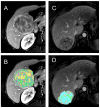Leveraging radiomics and AI for precision diagnosis and prognostication of liver malignancies
- PMID: 38779098
- PMCID: PMC11109422
- DOI: 10.3389/fonc.2024.1362737
Leveraging radiomics and AI for precision diagnosis and prognostication of liver malignancies
Abstract
Liver tumors, whether primary or metastatic, have emerged as a growing concern with substantial global health implications. Timely identification and characterization of liver tumors are pivotal factors in order to provide optimum treatment. Imaging is a crucial part of the detection of liver tumors; however, conventional imaging has shortcomings in the proper characterization of these tumors which leads to the need for tissue biopsy. Artificial intelligence (AI) and radiomics have recently emerged as investigational opportunities with the potential to enhance the detection and characterization of liver lesions. These advancements offer opportunities for better diagnostic accuracy, prognostication, and thereby improving patient care. In particular, these techniques have the potential to predict the histopathology, genotype, and immunophenotype of tumors based on imaging data, hence providing guidance for personalized treatment of such tumors. In this review, we outline the progression and potential of AI in the field of liver oncology imaging, specifically emphasizing manual radiomic techniques and deep learning-based representations. We discuss how these tools can aid in clinical decision-making challenges. These challenges encompass a broad range of tasks, from prognosticating patient outcomes, differentiating benign treatment-related factors and actual disease progression, recognizing uncommon response patterns, and even predicting the genetic and molecular characteristics of the tumors. Lastly, we discuss the pitfalls, technical limitations and future direction of these AI-based techniques.
Keywords: AI; HCC; liver tumors; radiomics; review.
Copyright © 2024 Haghshomar, Rodrigues, Kalyan, Velichko and Borhani.
Conflict of interest statement
The authors declare that the research was conducted in the absence of any commercial or financial relationships that could be construed as a potential conflict of interest.
Figures


Similar articles
-
Emerging Trends in AI and Radiomics for Bladder, Kidney, and Prostate Cancer: A Critical Review.Cancers (Basel). 2024 Feb 16;16(4):810. doi: 10.3390/cancers16040810. Cancers (Basel). 2024. PMID: 38398201 Free PMC article. Review.
-
Precision Population Cancer Medicine in Brain Tumors: A Potential Roadmap to Improve Outcomes and Strategize the Steps to Bring Interdisciplinary Interventions.Cureus. 2024 Oct 12;16(10):e71305. doi: 10.7759/cureus.71305. eCollection 2024 Oct. Cureus. 2024. PMID: 39529768 Free PMC article. Review.
-
Artificial intelligence in the diagnosis and management of colorectal cancer liver metastases.World J Gastroenterol. 2022 Jan 7;28(1):108-122. doi: 10.3748/wjg.v28.i1.108. World J Gastroenterol. 2022. PMID: 35125822 Free PMC article. Review.
-
Artificial Intelligence in Thyroid Field-A Comprehensive Review.Cancers (Basel). 2021 Sep 22;13(19):4740. doi: 10.3390/cancers13194740. Cancers (Basel). 2021. PMID: 34638226 Free PMC article. Review.
-
Artificial intelligence-based radiomics in bone tumors: Technical advances and clinical application.Semin Cancer Biol. 2023 Oct;95:75-87. doi: 10.1016/j.semcancer.2023.07.003. Epub 2023 Jul 26. Semin Cancer Biol. 2023. PMID: 37499847 Review.
Cited by
-
Evolving and Novel Applications of Artificial Intelligence in Abdominal Imaging.Tomography. 2024 Nov 18;10(11):1814-1831. doi: 10.3390/tomography10110133. Tomography. 2024. PMID: 39590942 Free PMC article. Review.
-
The current status and future directions of artificial intelligence in the prediction, diagnosis, and treatment of liver diseases.Digit Health. 2025 Apr 13;11:20552076251325418. doi: 10.1177/20552076251325418. eCollection 2025 Jan-Dec. Digit Health. 2025. PMID: 40290269 Free PMC article. Review.
-
Research on the developments of artificial intelligence in radiomics for oncology over the past decade: a bibliometric and visualized analysis.Discov Oncol. 2025 May 14;16(1):763. doi: 10.1007/s12672-025-02590-4. Discov Oncol. 2025. PMID: 40366503 Free PMC article.
-
MRI Radiomics in Imaging of Focal Hepatic Lesions: A Narrative Review.Cureus. 2024 Jun 17;16(6):e62570. doi: 10.7759/cureus.62570. eCollection 2024 Jun. Cureus. 2024. PMID: 39027765 Free PMC article. Review.
References
Publication types
LinkOut - more resources
Full Text Sources

